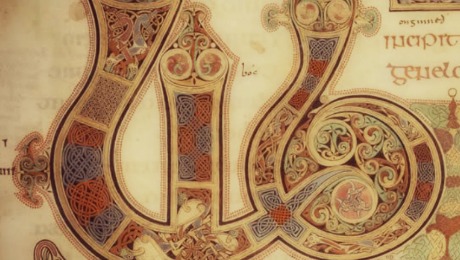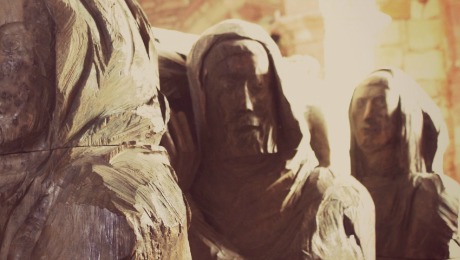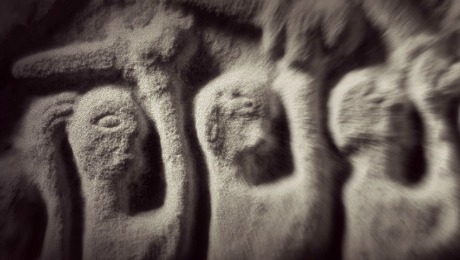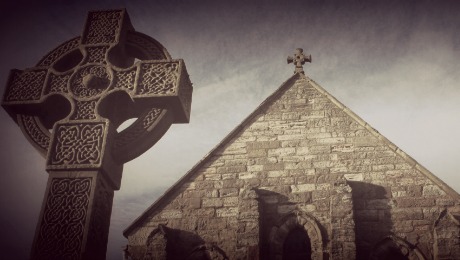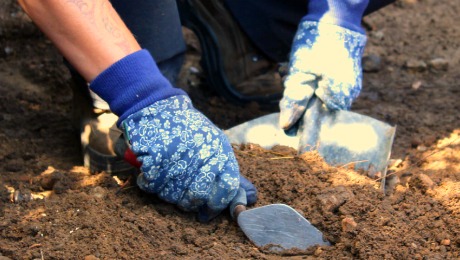In AD793, the Vikings launched their bloodiest attack on the British Isles yet. Their target was right here – the monastery at Lindisfarne.
“Never before has such a terror appeared in Britain”
Lindisfarne holds the dubious honour of being one of the first places in Britain to have been invaded by the Vikings. In AD793, the monastery was attacked by these fearsome raiders, probably attracted by the prospect of acquiring wealth and slaves. An important monastery, such as Lindisfarne, would have been well-stocked with elaborate reliquaries and church plate, making it a tempting and relatively easy target for the Vikings on one of their first campaigns into Britain.
Many Anglo-Saxons believe these Viking attacks had been prefigured by mysterious portents. The Anglo-Saxon Chronicle recorded:
“In this year fierce, foreboding omens came over the land of the Northumbrians, and the wretched people shook; there were excessive whirlwinds, lightning, and fiery dragons were seen flying in the sky. These signs were followed by great famine, and a little after those, that same year on 6th ides of January, the ravaging of wretched heathen people destroyed God’s church at Lindisfarne.”
This initial raid on Lindisfarne came as an immense shock, not only for the monks on the island, but the entire Northumbrian church, delivering a severe blow to the very heart of Christianity in the North. Many Christians saw it as a divine punishment for the unholy lives the population of northern England must have been living.
Directly after this assault, Alcuin of York (AD735-804), a Northumbrian scholar living in Germany, wrote to Higbald, Abbot of Lindisfarne bemoaning the attacks:
“What assurance can the churches of Britain have, if Saint Cuthbert and so great a company of saints do not defend their own? Is this the beginning of the great suffering, or the outcome of the sins of those who live there? It has not happened by chance, but is the sign of some great guilt”
After the first Viking attack on Lindisfarne, subsequent raids were initially rare occurrences, but by the mid-9th century the pace of Viking attacks seems to have increased with monasteries, like Lindisfarne, continuing to be soft targets.
Though the raids in Northumbria continued to be ‘smash-and-grab’ assaults, in other parts of northern England, particularly North Yorkshire, the Vikings started to settle more permanently, and in AD866 the city of York was conquered.
By AD875, the pressure on Lindisfarne became too much for the abbot, who ordered the holy relics of the church to be removed (among them the body of St. Cuthbert) and left with a contingent of monks to seek shelter on the mainland.
Initially, the monks headed to Norham, just seven miles inland, but this was merely the first stop on a century-long journey which saw the core of Lindisfarne’s community travelling across northern England, finally settling in Durham in AD995.
Whilst the majority of Lindisfarne’s monks embarked upon this journey, the presence of stone sculpture on the island clearly made after this date shows that some monks at least stayed behind on the island and continued to withstand further attacks by the Vikings.
Much of the religious stone sculpture from the island dates to after the core community left in the 10th century; one of the most famous carved stones, the so-called Battle Stone has even been associated with a Viking attack. Dating to the late 9th century, it shows a host of warriors, with swords and axes raised in their hands. This image is often associated with the Viking raiders, though we cannot be certain about who these warriors really were.
